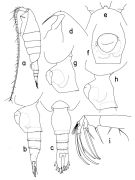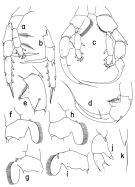|
|
 |
|
Calanoida ( Order ) |
|
|
|
Arietelloidea ( Superfamily ) |
|
|
|
Heterorhabdidae ( Family ) |
|
|
|
Heterorhabdus ( Genus ) |
|
|
| |
Heterorhabdus oikoumenikis Park, 2000 (F,M) | |
| | | | | | | Ref.: | | | Park, 2000 (p.125, figs.F,M, Rem.) |  issued from : T. Park in Bull. Scripps Inst. Oceanogr. Univ. California, San Diego, 2000, 31. [p.246, Fig.94]. Female: a, habitus (left side); b, c, urosome (left, dorsal, respectively); d, e, forehead (left, dorsal, respectively); f, g, genital somite (ventral, left, respectively); h, genital somite from different specimen (left); i, left Mx2 (posterior). Nota: Urosome 30% length of body. Length ratios of 4 urosomal somites and left caudal ramus 37.6 : 17.6 : 13.9 : 9.1 ; 21.8 = 100. A1 extending beyond posterior end of caudal ramus by its last 3 or 4 segments. Mx2: Posterior subterminal spine of 4th lobe 40% as long as 2nd saberlike spine; falcate spine of 5th lobe with proximal half of medial margin serrated with spinules and approximately 1.2 times length of saberlike.
|
 issued from : T. Park in Bull. Scripps Inst. Oceanogr. Univ. California, San Diego, 2000, 31. [p.247, Fig.95]. Female: a, P5 (anterior); b, exopod of P5 (posterior). Male: c, P5 (anterior); d, exopod of right P5 (posterior); e, second exopodal segment of right P5 (posterior); f, g, basipod of right P5 (anterior, posterior, respectively); h, i, basipod of right P5 from different specimen (anterior, posterior, respectively); j, exopod of left P5 (anterior); k, distal end of exopod of right P5 (lateral).
|
 Heterorhabdus oikoumenikis Heterorhabdus oikoumenikis female: 1 - See key to species groups of Heterorhabdus: ''abyssalis'' Group (p.90, 114). 2 - Genital somite without a conical projection mediodorsally (Fig.94- a, b). 3 - Laterally, genital somite without a tubercular outgrowth posteriorly on dorsal margin (Fig.94-b). 4 - Laterally, genital operculum far short of reaching posterior end of somite (Fig.94-b). 5 - Laterally, right and left genital flanges symmetrical. 6 - Laterally, genital prominence gradually merging onto ventral wall of somite (Fig.94-b). 7 - Dorsally, genital somite only slightly asymmetrical (Fig.94-c).
|
 Heterorhabdus oikoumenikis Heterorhabdus oikoumenikis male: 1 - See key to species groups of Heterorhabdus: ''abyssalis'' Group (p.90, 114). 2 - Basis of left P5 without a well-developed inner lobe (Fig.95-c). 3 - Basal inner lobe of right P5 armed with normal bristles (Fig.95-c, f). 4 - 3rd exopodal segment of right P5 with a short terminal lobe, slightly less than 1/3 length of terminal spine (Fig.95-c, d, k). 5 - Basal lobe of right P5 arising from anteromedial side of segment (Fig. 95-c, d). 6 - 2nd exopodal segment of left P5 with outer spine borne on a conical process (Fig.95-j). 7 - Basal lobe of right P5 nearly straight (Fig.95-c). 8 - Basal lobe of right P5 with an single band of bristles (Fig.105-f). 9 - Basal lobe of right P5 with an addirional row of bristles (Fig.95-i). 10 - 3rd exopodal segment of right P5 trmatibely short and curved (Fig.95-c).
| | | | | NZ: | 9 | | |
|
Distribution map of Heterorhabdus oikoumenikis by geographical zones
|
| | | | | | | | | | Loc: | | | Atlant. (S-N), W Gulf of Guinea, SW Indian, Malay Archipelago, China Seas (East China Sea, South China Sea), Pacif. (E-W: 40° N - S)
Type locality: 79,01°10'N, 11°36'W.
For Park (2000, p.126), this species has an extremely wide distribution, taken in the Atlantic between 35°19' S and 63°24' N; throughout the Pacific between 41°27' S and 40°35' N, and from the west coast of the America westward to the Malay Archipelago and East and South China Seas; also in the Indian Ocean at 28°05' S, 66°05' E. | | | | N: | 1 | | | | Lg.: | | | (824) F: 3,52-2,6; M: 3,28-2,4; {F: 2,60-3,52; M: 2,40-3,28} | | | | Rem.: | "Abyssalis" Group.
This species shows a very wide distribution in the Atlantic and in the Pacific, unfortunately without precision of localities in the documents consulted.
For Park (2000, p.127) this species is very close to H. longisegmentus. | | | Last update : 20/05/2017 | |
|
|
 Any use of this site for a publication will be mentioned with the following reference : Any use of this site for a publication will be mentioned with the following reference :
Razouls C., Desreumaux N., Kouwenberg J. and de Bovée F., 2005-2026. - Biodiversity of Marine Planktonic Copepods (morphology, geographical distribution and biological data). Sorbonne University, CNRS. Available at http://copepodes.obs-banyuls.fr/en [Accessed January 07, 2026] © copyright 2005-2026 Sorbonne University, CNRS
|
|
 |
 |





